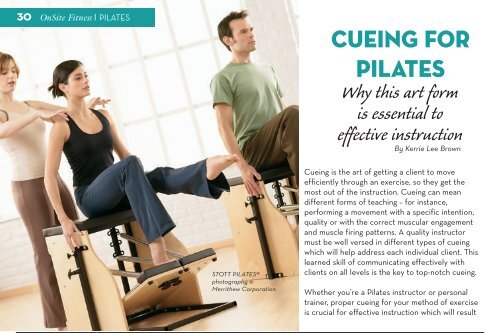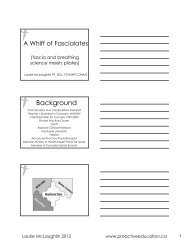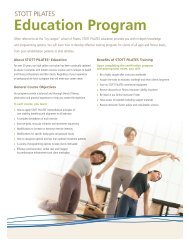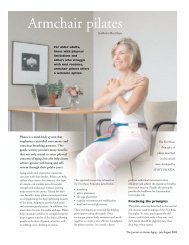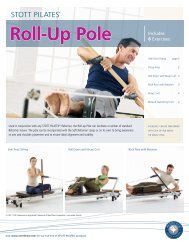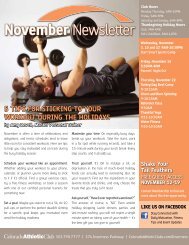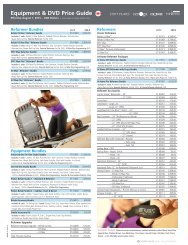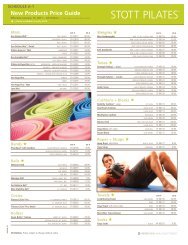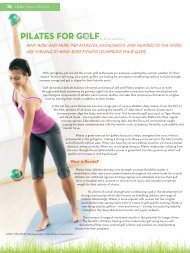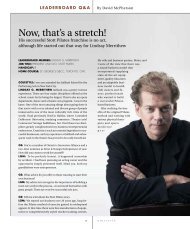CUEING FOR PILATES - Merrithew.com
CUEING FOR PILATES - Merrithew.com
CUEING FOR PILATES - Merrithew.com
Create successful ePaper yourself
Turn your PDF publications into a flip-book with our unique Google optimized e-Paper software.
30 OnSite Fitness | <strong>PILATES</strong><br />
<strong>CUEING</strong> <strong>FOR</strong><br />
<strong>PILATES</strong><br />
Why this art form<br />
is essential to<br />
effective instruction<br />
By Kerrie Lee Brown<br />
STOTT <strong>PILATES</strong>®<br />
photography ©<br />
<strong>Merrithew</strong> Corporation<br />
Cueing is the art of getting a client to move<br />
efficiently through an exercise, so they get the<br />
most out of the instruction. Cueing can mean<br />
different forms of teaching – for instance,<br />
performing a movement with a specific intention,<br />
quality or with the correct muscular engagement<br />
and muscle firing patterns. A quality instructor<br />
must be well versed in different types of cueing<br />
which will help address each individual client. This<br />
learned skill of <strong>com</strong>municating effectively with<br />
clients on all levels is the key to top-notch cueing.<br />
Whether you’re a Pilates instructor or personal<br />
trainer, proper cueing for your method of exercise<br />
is crucial for effective instruction which will result
<strong>PILATES</strong> | OnSite Fitness | www.onsite-fitness.<strong>com</strong> 31<br />
in best results for your clients. Experts agree that Pilates<br />
instructors need an extensive repertoire of cues, including broad<br />
categories of tactile (touch), auditory (verbal) and visual<br />
(demonstration). Each of these types of cuing can be further<br />
divided into relevant and useful subcategories such as directional<br />
cueing, which makes use of the surrounding environment to guide<br />
the client.<br />
<strong>FOR</strong>MS OF <strong>CUEING</strong><br />
According to Executive Director of Education for STOTT<br />
<strong>PILATES</strong>®, Moira <strong>Merrithew</strong>, cueing is often broken down into<br />
tactile and verbal forms – each can be equally effective<br />
depending on the individual client. “It is important to remember<br />
that each category can be broken down further,” Moira says.<br />
“A verbal cue can deal with imagery, anatomical function, or<br />
sensory perception. Even tactile cue can be used to bring<br />
awareness to a specific area or to help in firing an individual<br />
muscle or muscle group.”<br />
Proper cueing is crucial for high-caliber mind-body instruction.<br />
“The exercise we teach requires the whole body to work as a<br />
unit,” continues Moira. “It (cueing) is a learned discipline where<br />
the focus is on movement patterns which require a higher degree<br />
of participant skill and kinesthetic awareness. Our instructors cue<br />
the firing of our intrinsic musculature to execute refined patterns.<br />
When cueing these muscles in particular, the local and global<br />
stabilizers, our aim is to achieve stability with mobility and control<br />
of each pattern.”<br />
THE FIVE BASIC PRINCIPLES<br />
Without question, the cues that are emphasized most are those<br />
that incorporate modern theories of exercise science and spinal<br />
rehabilitation and involve biomechanical theories of breathing,<br />
pelvic placement, rib cage placement, scapular movement and<br />
stabilization, and head and cervical spine placement. By<br />
introducing these principles and reinforcing them through a<br />
workout, awareness of how the body moves is developed. This<br />
mind-body awareness ensures focus on precision and control to<br />
help realize the full benefits of an exercise program. Cues that<br />
are founded in these principles ensure clients are maintaining a<br />
kinesthetic awareness of the body.<br />
Furthermore, cues that relate to proper breathing technique<br />
promote effective oxygenation of the blood, focus the mind on<br />
each task and help avoid unnecessary tension during exercise.<br />
Encouraging exhaling deeply helps activate the deep support<br />
muscles of the body. Activation of the deep stabilizing muscles<br />
(pelvic floor and transversus abdominis) are integral in<br />
maintaining stabilization of the lumbo-pelvic region and<br />
should be encouraged and incorporated into the breath pattern<br />
of every movement.
32 OnSite Fitness | <strong>PILATES</strong><br />
Effective cues will also emphasize stabilization of the pelvis and<br />
lumbar spine both statically and dynamically in all positions and<br />
throughout all movements. Cueing pelvic stability during an<br />
exercise will ensure optimal performance of the movement and<br />
help prevent any unnecessary stress on the lumbar spine. The<br />
abdominal muscles must often be recruited to maintain the rib<br />
cage, and indirectly, the thoracic spine, in proper alignment.<br />
Instructors must cue participants to prevent the rib cage from<br />
lifting up in the supine position or deviate forward in a sitting<br />
position, causing the thoracic spine to extend.<br />
STOTT <strong>PILATES</strong>®<br />
photography ©<br />
<strong>Merrithew</strong> Corporation<br />
Instructors should remain aware of cueing stabilization of the<br />
scapulae and shoulders and realize the importance during the<br />
initiation of every exercise. When stability is absent, there is a<br />
tendency to overwork muscles around the neck and shoulders.<br />
Since they lack a direct bony attachment to the rib cage and<br />
spine, the scapulae have a great deal of mobility in making a<br />
greater range of motion available to the arms. Although the<br />
scapulae move with the arms, a sense of stability, not rigidity,<br />
should always be maintained.<br />
Regarding head and cervical spine placement, the cervical spine<br />
should hold its natural curve and the skull should balance directly<br />
above the shoulders when sitting in neutral. This position should<br />
also be maintained when lying on the back. In most instances, the<br />
cervical spine should be encouraged to continue the line created<br />
by the thoracic spine during flexion, extension, lateral flexion and<br />
rotation. Continually referring to these biomechanical principles<br />
will ensure that the cues an instructor is providing will help all<br />
clients or groups perform the exercises to the best of their ability.<br />
INEFFECTIVE CUES & UNDERSTANDING YOUR CLIENT<br />
According to research, one of the most overused cues in the<br />
Pilates industry at large is ‘slide your shoulders down.’ “While this<br />
may be effective with a small percentage of client groups, it can<br />
also have some very detrimental effects on others,” says Moira.<br />
“In many participants, sliding the shoulders down may overly
<strong>PILATES</strong> | OnSite Fitness | www.onsite-fitness.<strong>com</strong> 33<br />
depress them, produce <strong>com</strong>pression on nerves of the neck and<br />
shoulders and decrease the range of motion in the shoulder joint.<br />
To be more effective, instructors should look at each client their<br />
individual needs to determine what the optimal cue is for them.”<br />
“It is important to understand what type of a learner the client is<br />
and then be able to select cues that will be appropriate for that<br />
individual. Someone who is a “thinker learner” will want to know<br />
the intricacies of a movement and may not respond as well to<br />
visual images. In this case, using phrases such as ‘feel the head of<br />
the femur rotating freely within the hip socket’ may elicit a better<br />
response.<br />
To conclude, an effective Pilates instructor will be able to relate<br />
to any type of client, no matter how they learn best, by having a<br />
well stocked tool box of cues available at a moment’s notice. A<br />
good practice exercise for instructors on their own is to go<br />
through 5-10 repetitions of an exercise and use a different cue for<br />
each repetition. Instructors should be clear in their own mind<br />
why they are teaching a client a particular exercise or<br />
modification. This will ensure they will be able to develop a<br />
rapport with any client who walks in their door.<br />
More importantly, emphasizing positive reinforcement when<br />
working with clients is crucial to effective cueing, and therefore<br />
effective Pilates instruction. Many clients will react quicker if they<br />
are told why they are doing a particular exercise a certain way as<br />
opposed to it being thrown at them because it <strong>com</strong>es next on the<br />
chart. So next time you’re thinking about how to approach your<br />
client with a new exercise or movement – remember to think<br />
about their individual needs and how to approach them with the<br />
change. It’ll make all the difference.<br />
OSF<br />
For more information on Cueing or Pilates Education, visit<br />
www.stottpilates.<strong>com</strong><br />
STOTT <strong>PILATES</strong>®<br />
photography ©<br />
<strong>Merrithew</strong> Corporation<br />
Kerrie Lee Brown is Vice President of Communications at STOTT<br />
<strong>PILATES</strong>®


